EQUIPMENT TEST REPORTS: Hirsch-Houck Laboratory test results on the Hitachi D-3500 cassette deck, Shure M95ED phono cartridge, Rectilinear 5 speaker system, and SAE Mark lB preamplifier
--
By Hirsch-Houck Laboratories
Hitachi D-3500 Cassette Deck
Mos-r of the few three-head cassette recorders to reach the market have been notable for both their high performance and correspondingly high price. The new D-3500 cassette deck from Hitachi is dramatically less expensive than the typical three-head machine, and it has an overall performance level that falls between that of a high-quality two-head machine and the very expensive three-head models.
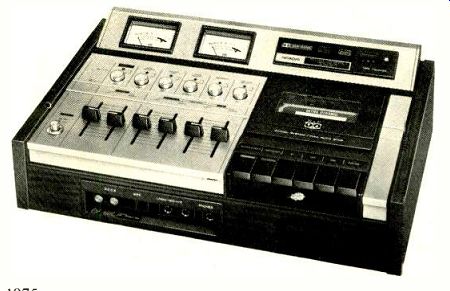
The Hitachi D-3500 has separate recording and playback heads within a common housing. This assures that their alignment relative to each other will be permanent. The com bined head structure is small enough to fit through the center opening in the edge of the cassette where the conventional record/play head goes, the two distinct gaps being close enough to share the cassette's built-in pressure pad. The playback gap is 1.2 microns (µ) wide, while the head's recording gap is 4 it wide, both dimensions being optimum for their application. There are separate recording and playback electronic sections, including separate Dolby encode and decode systems for both functions ( Hitachi refers to these as "Double Dolby"). This permits a program to be recorded with Dolby encoding and monitored from the tape in decoded form with the correct frequency balance and improved signal-to-noise ratio.
The tape transport is driven by a four-pole hysteresis-synchronous motor. The controls are fairly conventional "piano keys" along the front edge of the horizontal control panel. The STOP/EJECT key stops the transport when pressed once; releasing it and pressing again ejects the cassette. It is possible to go from normal speed to fast speed in either direction or to shuttle between the two fast-speed modes without using the STOP button, but the tape must be stopped before it can be put into PLAY or RECORD. A hinged cover in front of the cassette door lifts to expose the heads for cleaning. On the sloped rear of the panel are REC (record) and PLAY signal lights and the pushbutton-reset index counter. To their left are two large illuminated level meters.
Along the left front of the panel are six slider level controls--two each for the line and microphone inputs (which can be mixed) and two for playback-output level. The pushbutton POWER switch is at the left front. A row of six large pushbuttons behind the level sliders controls MONITOR (from source or tape), INPUT SELECT (line only, or line and microphone mixed), DOLBY, TAPE (bias and equalization for "normal" and chromium-dioxide tape), MEMORY (an automatic stop in rewind at the point where the index counter reads 000), and METER. The last, in its vu position, gives the meters the ballistic properties of a true VU meter, while in the PEAK position they have a very fast rise and a much slower decay time, permitting them to respond to very brief program peaks. The status of each button is indicated by an adjacent light. With CrO2 (chromium-dioxide) cassettes having the special rear-edge notching (most current production does), the CrO2 bias and equalization are selected automatically when the cassette is inserted. There is no way to defeat this action manually unless the notch itself is blocked by a piece of tape.
Recessed into the front of the recorder's wooden base are the microphone and head phone jacks, an MPX button that cuts off input signals above 15,000 Hz to prevent FM pilot-carrier leakage from affecting the Dolby system, and the Dolby calibration controls. The ability to monitor from the tape while recording makes the Dolby calibration a very simple process--the noise-reduction system can be adjusted for any kind of tape in a few seconds.
In the rear of the machine are the line inputs and outputs, a DIN socket, and a switch that removes the source program from the line outputs. The Hitachi D-3500 is approximately 17 inches wide, 11 inches deep, and 51/2 inches high; it weighs about 15 1/2 pounds. Price: $399.
Laboratory Measurements. The playback frequency response of the Hitachi D-3500 was measured with the Teac 116SP (CrO2 equalization) and Nortronics AT-200 ("standard" equalization) test tapes. The CrO2 test-tape response was within-.±2 dB from 40 to 10,000 Hz; the "standard" tape response was smooth and free of sharp peaks or dips, but sloped downward slightly with in creasing frequency above 1,000 Hz and showed the expected rise below 200 Hz be cause of the older equalization characteristic of the Nortronics tape. Referred to the 1,000-Hz level, it varied +0 to -6 dB over the range for which the tape's equalization is correct.
All tests of the recorder's overall record-playback response were made with Hitachi "Low Noise" (LN) and "Chrome Dioxide" (CrO2) cassettes, which were supplied with the machine. Both were C-90 cassettes. The response with the LN tape was ±1.5 dB from 30 to 12,500 Hz at a-20-dB level. It dipped to a minimum at about 15,000 Hz, and then rose at higher frequencies. From 20 to 20,000 Hz, the variation was only about ±3 dB. The CrO2 tape gave an extremely flat response:.-±-2 dB from 30 to 18,000 Hz and ±3.5 dB from 20 to 20,000 Hz. The 0-dB response curves, as expected, rolled off at a much lower frequency than the-20-dB curves, but unlike the usual case, neither fell below the -20-dB response for any significant portion of the frequency range; even more surprisingly, the LN tape had at least as good a 0-dB response as did the CrO2 tape.
The M PX filter had almost no effect in the audible range, reducing the 15,000-Hz output only about I dB, and, as it should, it attenuated the 20,000-Hz response by about 20 dB.
The Dolby tracking was good, with an effect of less than 2 dB on the response at any frequency when the Dolby system was used during recording and playback at levels of-20 and-30 dB.
A line input of 45 millivolts (mV) produced a 0-dB recording level, and the line inputs overloaded at a safe 3 volts. The microphone sensitivity for 0 dB was 0.26 mV, but the microphone preamplifier overloaded at a rather low 19 mV, which means that external attenuators should be used with high-output micro phones. The output from a 0-dB recorded signal, which also read 0 dB during playback was 0.78 volt. The headphone volume was quite low with 200-ohm phones.
The total harmonic distortion at a 0-dB re cording level was 1.4 percent with LN tape and 2.1 percent with CrO2 tape. The reference 3 percent distortion level was reached at a high +6 dB with LN tape and +2 dB with CrO2 tape. The unweighted signal-to-noise ratio of both tapes, referred to those levels, was 51 dB, and it improved to 56 dB with IEC "A" weighting. With the Dolby system in use, this improved further to an impressive 65 dB, one of the best S/N measurements we have measured on a cassette recorder.
A standard Dolby level tape gave a +2-dB reading, coinciding with the Dolby marks on the recorder's meters. In the vu mode, the meter ballistics were close to those of a true VU meter, with a rapid rise and return on 0.3-
second tone bursts and an overshoot of about 10 percent. In the PEAK mode, the meter read 100 percent of its steady-state value on the
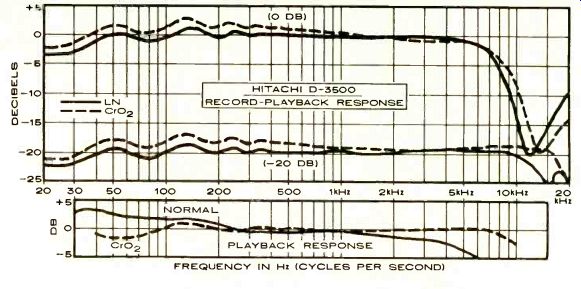
-------- FREQUENCY IN HZ (CYCLES PER SECOND)
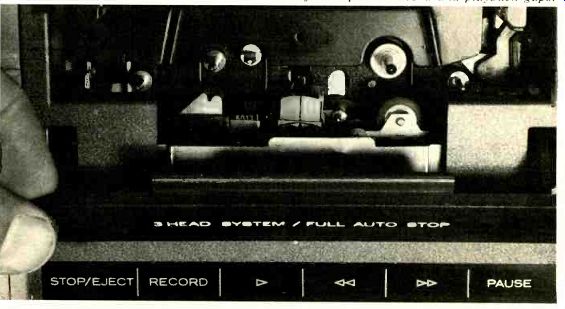
-------- The head arrangement of the Hitachi D-3500 appears
conventional despite the "3-Head System" marking. However, the
center head has four separate record and playback gaps.
bursts, and returned to zero quite slowly (with a time constant on the order of a second or two). Wow of the transport was un-measurably low (0.01 percent, which is the residual of our test equipment), and the unweighted rms flutter was 0.14 percent. In fast forward, a C-60 cassette was handled in 74 seconds, and rewinding required 81 seconds.
Comment. When we received the Hitachi D-3500 for testing, we did not know its price. From its features, we judged that it would be an excellent value at $500, and estimated that it would sell between $500 and $550. Need less to say, we were surprised by its very modest (by today's standards) cost.
The D-3500 is a very easy, unfussy ma chine to use. Once the Dolby system is calibrated (it takes less time to do than to de scribe), it handles like any other cassette recorder. When we first used the MONITOR button to compare the original and recorded programs, we had to use the pause lever to convince ourselves that we were really hearing the playback from the tape and not merely the input signal. In every case where we re corded from a disc or an FM broadcast, there was no audibly detectable difference between the signal from the source and the signal played back from the tape! Even when re cording interstation hiss from an FM tuner, we heard only the slightest modification of the hiss frequency spectrum.
We preferred to use the PEAK meter mode exclusively, seeing no advantage to the vu mode. When the maximum peak meter reading is kept below 0 dB, there is almost no likelihood of tape saturation or distortion; with VU indications, the "safe" readings must be kept considerably lower and are not as unambiguously related to the recorder's or the tape's limits.
The Hitachi D-3500 would seem to be an excellent choice for the cassette enthusiast who is not quite enthusiastic enough to invest several hundred dollars more than the price of this recorder, yet would like to enjoy the benefits of separate recording and playback heads (which are every bit as applicable to cassette recording as to the open-reel format).
As far as we can tell, nothing has been skimped on this machine, which has just about every useful feature we have seen on competitively priced two-head machines, with the possible exception of FM Dolby decoding and solenoid-operated controls. We would gladly sacrifice these features, attractive as they are, in favor of top-quality three-head cassette recording, with full "Double Dolby" circuitry, at a $400 price. No doubt there will be others coming to somewhat the same conclusion.
==========
Shure M95ED Phono Cartridge
SOME of the design improvements that went into Shure Bros.' V-15 Type III have now been incorporated into a new phono cartridge, the M95ED. Billed by Shure as their "second-best" cartridge, it is available at a price substantially below that of the V-15 Type III. Two of the most important factors in improving the frequency-response flatness and tracking ability of the V-15 Type III were the use of a new high-efficiency laminated magnetic structure and a reduction in effective stylus mass. The M95ED also has a re-designed magnetic system, and although it is not laminated, it does embody many of the concepts employed in the V-15 Type III. The M95ED tip mass has been reduced to about 0.5 milligram, roughly that of the earlier V-15 Type II Improved--in fact, Shure states that the high-frequency tracking of the M95ED is equal to that of the Type II Improved. However, the M95ED has been given the sonic character of the latest V-15 Type Earlier Shure cartridges typically had a slight dip in the upper mid-range of a couple of deci bels, whereas the Type III (and the M95ED) have a virtually flat response throughout the audible range. The physical appearance of the M95ED is also similar to that of the V-15 Type III, including the integral swing-away stylus guard. According to Shure's data, the tracking ability of the M95ED at a 1-gram force is about equal to that of the V-15 Type III operated at 0.75 gram. Price: $59.95.
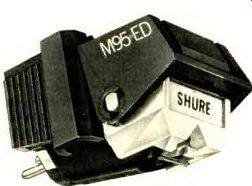
Laboratory Measurements. The Shure M95ED was tested in the tone arm of a typical high-quality record player. Initial tracking tests showed that it could trace the high-level low- and mid-frequency portions of the Cook Series 60 and Fairchild 101 test records at 1 gram, and we used that force in our subsequent tests. At 1 gram, the 300-Hz test bands of the German Hi-Fi Institute test record were tracked at a 60-micron (µ) amplitude; at the 1.5-gram maximum rated force, the cartridge tracked the 90 µ band (this is a severe test of tracking ability).
The output at a standard velocity of 3.54 centimeters per second (cm/sec) was 4.3 milli volts per channel. A 1,000-Hz square wave showed several cycles of ringing at the stylus resonance frequency of about 20,000 Hz.
The M95ED's high-frequency tracking ability was evaluated using the 10.8-kHz tone bursts of the Shure TTR-103 test record, and it proved to be one of the better cartridges we have tested in this regard. Intermodulation distortion measurements, using the Shure TTR-102 record, indicated that the distortion ...

---------------- In the graph at left, the upper curve represents the
smoothed, averaged frequency response of the cartridge's right and left channels;
the distance (calibrated in decibels) between it and the lower curve represents
the separation between the two channels. The inset oscilloscope photo shows
the cartridge's response to a recorded 1,000-Hz square wave, which gives
an indication of resonances and overall frequency response. At right is the
cartridge's response to the intermodulation-distortion (IM) and 10.8-kHz
tone-burst test bands of the TTR-102 and TTR-103 test records. These high
velocities provide a severe test of a phono cartridge's performance. FREQUENCY
IN Hz (CYCLES PER SECOND) kHz PEAK VELOCITY IN CM/SEC OF TEST DISC
... was low at normal recording levels, and it remained an impressively small figure, even at a 1-gram tracking force. The intermodulation distortion measured by the TTR-102 remained low with recorded velocities as high as are likely to be encountered on conventional music discs.
Shure cartridges require a relatively high capacitive load (400 to 500 picofarads) for flattest frequency response. We checked the response with a 200-pF load (the turntable's connecting cables) and again with added capacitance to bring the total to about 440 pF.
With the lower capacitance, there was a peak of about 4 dB centered at 16,000 Hz; the higher capacitance flattened the curve to an excellent ±1 dB from 40 to 17,500 Hz, drop ping slightly to-4 dB at 20,000 Hz. The channel separation was excellent, exceeding 30 dB up to about 2,000 Hz, and gradually falling to 17 dB at 10,000 Hz and 5 dB at 20,000 Hz. The separation characteristics of both channels (as well as their frequency responses) were identical.
Comment. A comparison of their published specifications suggests that, except for an in crease of 400-Hz tracking ability from 22 to 24 cm/sec, the Shure M95ED and M91ED are very similar. This, of course, does not take into account their rather different upper mid range frequency-response characteristics. In an A-B comparison between them, we could hear their distinctly different tonal qualities.
The M91ED had a slightly heavier, warmer sound, while the M95ED seemed brighter and-at times-crisper and better defined.
The differences were slight, and in our opinion they were not of the magnitude that would establish one of the cartridges as clearly superior to the other.
With the Shure "Audio Obstacle Course Era III" record (TTR-110), all selections except the sibilant test were tracked at their maximum levels at the 1-gram test force. A trace of "sandpaper" quality was heard on the two highest levels of the sibilance test, and was not removed by increasing the tracking force to 1.5 grams.
Our view is that the Shure M95ED falls very neatly into the gap between the M91ED and the V-15 Type UI. Its performance in most respects is closer to that of the V-15 UI, but its cost is not! For those who prefer the more "forward" sound of the V-15 Type UI, but are unwilling or unable to make the considerable investment in that cartridge, the M95ED would seem to be an ideal choice. It has the general sound quality of the V-15 Type III, and most of us will rarely encounter recordings that demand the superior tracking ability of the latter. Best of all, we note that the M95ED is available with substantial discounts from a number of dealers, making it an exceptionally attractive value.
+++++++++++++++++
Rectilinear 5 Speaker System \
THE Rectilinear 5 is a four-way speaker system whose 12-inch woofer operates in a sealed enclosure. At the unusually low frequency of 200 Hz there is a crossover to a 7-inch upper-bass/mid-range driver housed in a separate sealed chamber within the main en closure. The next crossover, at 1,800 Hz, is to a 1 1/2-inch dome tweeter, followed by a final crossover at 10,000 Hz to a 1-inch dome super-tweeter. Except for the woofer, each driver is permitted to operate over its full range above its low-frequency crossover. The frequency balance of the system is set at the factory by means of two screwdriver-slot adjustments in the rear of the cabinet. These are sealed to discourage tampering.
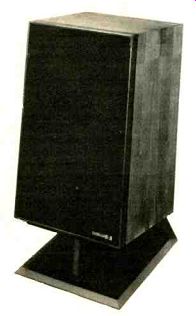
The Rectilinear 5 is nominally a 6-ohm system, rated for use with amplifiers delivering from 30 to 250 watts per channel. It is protected by a 3-ampere fast-blow fuse, and a clip in the rear of the cabinet holds a spare re placement fuse (a handy touch we would like to see adopted more widely).
The oiled walnut cabinet is 25 by 15 by 14 1/2 inches and weighs about 55 pounds. The black cloth grille is removable, and the system can be installed horizontally or vertically. Although it is described as a "bookshelf/ floor" system, few bookshelves are deep and sturdy enough to support this speaker. Recognizing this, Rectilinear offers an optional "dispersion base" for floor mounting. This tilts the face of the speaker upward about 10 degrees for more effective dispersion, and it is claimed to minimize room boundary effects on the mid-bass response. The Rectilinear 5 sells for $299, and the optional tilt base is $20
Laboratory Measurements. The composite frequency-response curve (roughly corresponding to the total-power response of the Rectilinear 5) was flat within ±2.5 dB from 38 to 6,000 Hz and had a broad rise between 6,000 and 17,000 Hz. Overall, the measured total response variation of ±5 dB from about 40 to 20,000 Hz represents a much better than average flatness for a loudspeaker in a "live"-room measurement. The bass distortion was about 1 percent between 80 and 100 Hz (at a 1-watt constant input) and increased smoothly to a mere 5 percent at 20 Hz, except for an inaudible rise to slightly below 4 percent at 40 Hz. With a 10-watt input (a very loud level) the distortion was roughly twice as great as with a 1-watt input.
The minimum impedance of the Rectilinear 5 was 5 ohms at 100 Hz and above 15,000 Hz. The maximum was 10 ohms at the bass resonance of 40 Hz, and the average was about 8 ohms over most of the audio range. Although many speaker manufacturers would probably call this an 8-ohm speaker, we commend Rectilinear for their more realistic rating.
For an acoustic-suspension system, the Rectilinear 5 was quite efficient, producing a 92-dB sound-pressure level (SPL) at a distance of 1 meter with 1 watt of random-noise input in the octave centered at 1,000 Hz. Its tone-burst response was very good, with nearly ideal bursts at low and middle frequencies and only minor-and inaudible-ringing following a 5,000-Hz burst.

--------- These oscilloscope photos show the fine tone-burst performance
of the Rectilinear 5 at (left to right) 100, 1,000, and 5,000 Hz.
Comment. The simulated live-vs.-recorded listening test confirmed the essential flatness and lack of coloration of the Rectilinear 5. The high-frequency emphasis revealed by our measurements added a trace of sparkle at the highest frequencies which could be removed, if desired, by a cut of 2 to 3 dB at frequencies above 8,000 Hz. The dispersion of the system was also very good, and without recourse to any special dispersion-enhancement design techniques.
We were especially interested in the relative performance of the Model 5 compared with the very early original Rectilinear Model III which earned itself a rave review in 1967. (Since that time the III has undergone numerous revisions and is now known as the IIIa).
The measured curves of the original III and of the 5, though quite similar in their overall shape, indicate a slightly crisper sound in the Model 5. And when we made an A-B comparison against a pair of our Model III's, that is just what was heard. Not only is the Rectilinear 5 a trifle brighter at the extreme top end, but it has better dispersion and a much more powerful deep bass. Although it is a smaller system, the Model 5 has an acoustic-suspension woofer that is clearly able to go down lower in the audio spectrum, and with less distortion, than the ported woofer of the III. There was a notable absence of mid-bass coloration or "boominess," combined with a potent low-bass capability.
All in all, the Rectilinear 5 is a distinct improvement over its predecessors in the line, apparently without sacrifice of any their desirable qualities. We think it is noteworthy that this has been accomplished without a price increase, and with a substantial reduction in cabinet size.
++++++++++++++++++
SAE Mark IB Preamplifier
THE SAE Mark IB is a deluxe stereo pre amplifier/equalizer designed as a companion to the power amplifiers manufactured by SAE and others. The most prominent and unique feature of the Mark IB is its seven-band graphic equalizer whose slider controls dominate the unit's front panel.
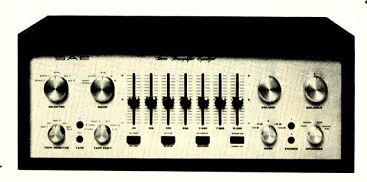
The equalizer uses toroidal inductance/capacitance filters with center frequencies of 40, 120, 320, 960, 2,500, 7,500, and 15,000 Hz. The sliders, lightly detented at their center (flat) positions, provide a maxi mum gain variation in their respective frequency bands of either ±16 or ±8 dB, de pending on the setting of one of four push buttons on the front panel. The other buttons control the a.c. power to the Mark I B, by pass the equalizer circuits, and transfer the equalizing function to the tape-recorder outputs or the line outputs.
The input selector at the upper-left corner of the panel has positions for two magnetic phono cartridges, tuner, and two additional high-level (Aux) sources. A MODE switch provides normal or reversed-channel stereo or connects either input channel or their sum (mono) to both outputs. Below these controls are two switches for the tape-recording functions. The TAPE MONITOR can control three tape decks, two of which connect to the rear of the unit and the third through a pair of stereo phone jacks on the front panel. The play back output of any of these machines can be channeled through the preamplifier circuits to replace the normal selected input program.
The six-position TAPE COPY switch interconnects the tape decks for dubbing from any one to any other.
At the upper right of the panel are large knobs labeled VOLUME and BALANCE. The volume control is a twenty-three-position step switch which maintains a channel balance within ±-0.1 dB over its 33-dB control range (the lowest position shuts off the sound completely). The balance control is lightly detent ed. Since 33 dB is not an adequate volume-control range, a smaller GAIN switch below the volume control changes the gain in 12-dB steps over a 48-dB range. Once it has been set for normal listening levels, all volume adjustment can then be made with the volume control. The Mark I B will accept the power amplifier's speaker outputs and channel them to either main or remote speakers, to both, or to the headphone jacks by means of a SPEAKERS switch at the lower right of the panel. The two stereo headphone jacks are driven from the power-amplifier outputs through isolating resistors.
The rear apron of the SAE Mark IB, in addition to its basic input and output jacks, has a second pair of MAIN outputs and a pair of outputs for driving the vertical and horizontal inputs of an oscilloscope. A pushbutton switch in the rear provides the option of in creasing the overall preamplifier gain ten times (20 dB) should the available gain be inadequate.
A cable assembly supplied with the Mark IB carries the power-amplifier speaker outputs into the preamplifier via a four-pin socket. Heavy-duty binding posts are provided for connection to the speaker systems. There are six switched a.c. outlets (rated for a total of 1,000 watts) and two unswitched a.c. outlets.
The satin gold-finished front panel of the SAE Mark LB is 17 inches wide and 5 3/4 inches high, and the chassis extends 10 1/2 inches be hind the panel. The unit weighs 20 pounds. An accessory wood cabinet is available. Price: $750.
Laboratory Measurements. With the front-panel GAIN switch set to its mid-position (0 dB), the volume control at maximum, and the rear gain switch at x10, the input level required for a 1-volt reference output was 1.75 volts (Aux) and 14 millivolts (mV) at the PHONO inputs. Setting the GAIN to +24 dB (the maximum) raised these figures to 98 mV and 0.78 mV, respectively. In both cases, the phono-input overload was a very safe 82 mV.
The output noise was unmeasurable through the high-level inputs, being less than the 100-microvolt lower limit of our test equipment. This translates to better than-80 dB referred to 1 volt. Through the PHONO input, the noise level was 75 dB below 1 volt, or 83 dB below the Mark I B's rated 2.5-volt audio-signal output.
The output clipped at 12.5 volts into a high- impedance load and at 11.4 volts into the 10,000-ohm rated minimum load. The harmonic distortion at 2.5 volts was 0.025 percent at 20 Hz (including hum components) and about 0.0075 percent at all frequencies up to 20,000 Hz with the hum filtered out (this "hum," of course, was far below audibility and was significant only in comparison to the minuscule distortion of the preamplifier). Intermodulation distortion was 0.025 percent at 0.1-volt output, less than 0.01 percent at outputs of 1 volt or slightly more, and 0.021 percent at the rated 2.5 volts. Just below clipping, at 10 volts output, the IM was still only 0.2 percent and the harmonic distortion was 0.067 percent.
The equalizer response curves conformed to specifications and should make it practical to correct for many room and loudspeaker aberrations in a manner not possible with less elaborate "tone controls." The RIAA equalization was extremely accurate, within ±0.5 dB over the entire audio range, and we were pleased to see that equalization was essentially independent of cartridge inductance, which affected the response by less than 1 dB at 20,000 Hz.
Comment. When it comes to operating and control flexibility, the SAE Mark IB has few peers. The tape-recording hobbyist in particular can not only dub with ease between as many as three machines, but he can insert the equalizer into the recording path at the touch of a button. The equalizer, of course, is at the heart of the Mark IB's performance capability. In our view, the seven specific bands chosen by SAE are an ideal compromise between the ten or more bands of an octave equalizer (which can be quite cumbersome to adjust) and the simpler five- or three-band versions offered by some manufacturers. The controls are easy to adjust, they produce immediately audible effects, and they are actually able to equalize the response of many speakers effectively. (For example, we were able to make some fairly good but undistinguished speakers sound very much like our flat, calibrated laboratory reference models.) Although the Mark IB offers more gain-setting options than we can recall seeing on any other preamplifier, most of them are in the "set and forget" category. It is doubtful if the distortion or noise Characteristics of the preamplifier could be degraded significantly by any possible combination of these control settings. If they are adjusted so that the main volume control has adequate range, they are correct.
The speaker-switching arrangement, al though it necessitates bringing even more wires to the rear of the preamplifier than would otherwise be required, gives the system the output flexibility of a good receiver, which is one of the few features not usually available to the user of separate components. All in all, our tests and use reveal the SAE Mark IB to be a truly excellent (albeit somewhat expensive) performer that ranks among the finest available components.
---
NEW PRODUCTS: A roundup of the latest in high-fidelity equipment
TURNTABLE BASICS: A little preliminary homework will make you a lot smarter in the market